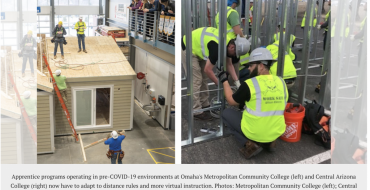
Construction apprentice programs are facing a new learning curve since the introduction of COVD-19. Please find the original article here by Engineering News-Record
New COVID-19 restrictions are already affecting the craft worker pipeline, forcing many apprenticeship and training programs to be shuttered or severely limited. Programs are turning to online resources, on-the-job training and socially distanced classes to continue critical workforce development.
In Washington, training programs are reopening after the state issued new safety rules for higher education in early May, says David D’Hondt, executive vice president of the Associated General Contractors chapter. Apprenticeship enrollment was at an all-time high before the shutdown in March, he notes.
Programs now must figure out how to follow guidelines, such as 6-ft distancing, in classrooms and training areas. “There will be a bottleneck in trying to move people along,” he says. Training leaders also anticipate fewer graduates “because you won’t be able to fit as many people into classrooms.” D’Hondt, a state apprenticeship council member, says adjudicative hearings, required to apply for apprentice programs, have been delayed.
Imperative to Restart
The state’s oldest continuously running construction pre-apprenticeship program, ANEW, dating to 1980, had to shut down on March 23 and hopes to restart on June 1 “with COVID 19 policies in place,” says Executive Director Karen Dove. “We have been converting to partial online training, but the learning curve for our instructors and staff has been difficult.” she says. “We lost students who were in the middle of training because of other priorities due to the stay home, stay healthy directive in Washington.”
Dove says “it is imperative we get [apprentice programs] up and running! Without them, there is no place for our graduates to go! We have graduates lining up waiting for applications to be accepted again. I also think it will be important because the [COVID-19] changes may cause some of the older workers to finally retire instead of adapting. which will create opportunities for new workers.”
The Northern California Carpenters Regional Council typically would have hundreds of apprentices at its five main training centers, but those were shut down in mid-March. Augie Beltran, council spokesman, says the group worked with the parent international union’s training center to create programs that follow federal virus guidelines, but there’s no in-person training now at its centers. The council shifted to some online education and testing that would otherwise be in classrooms but looks to jobsites for hands-on training. “There’s going to be a lot more in-field training now,” he says.
In New Jersey, the International Union of Operating Engineers large Local 825 suspended its March and April training, and “we’re looking at how to ramp up a Google classroom and Zoom webinars,” says business manager Greg Lalevee. “But it’s not the way we’re used to it. You can’t jump on the [machine’s] running board anymore to help a student.”
Take-home Kits
At Metropolitan Community College in Omaha, Neb., many students saw their graduations put on hold when the school’s on-campus apprentice programs shut down in mid-March. Nathan Barry, dean of career and technical education, says most students have not met all requirements from spring classes. Faculty are assisting “to figure out how to meet competencies without students paying for a class again,” he says. Take-home kits, such as a set of electrical components, could be used for virtual basic electrical theory classes. Still, more must be done in coming months. “We can’t consciously send students out to the industry and say they are qualified and ready to go,” Barry says.
The school is prioritizing students who are close to graduating. Indoor classes that once held 12 to 15 students could be reduced to less than 10, with staggered times. Six-ft-by-six-ft areas can be taped off for social distancing with plastic sheets, where necessary. “We have to convert all of our labs to meet social distancing,” he adds. “We can’t continue to do stuff online and feel comfortable they are getting the training they need.”
Due to the job market downturn, the college expects enrollment requests to rise, but with a limit in class sizes. “We expect to see a 10% to 15% enrollment drop, while our waitlists will be longer,” says Barry.
Rules of Engagement
Central Arizona College in Coolidge, Ariz., was able to run a pilot program this spring to test the use of new guidelines, say James Busch, director of skilled trades and workforce development. Classroom work was moved online and hands-on training was moved from indoor labs to outdoor spaces. Classes are limited to ten, including instructors. Students show up on class days at staggered times for briefings and health checks. After all training is complete, all equipment has to be sanitized.
As a result, four-hour-long classes can only accommodate around three hours of instruction time, Busch says. “This has caused instructors to step out of their comfort zone a little bit and become more comfortable with different ways of delivering training,” he says. “I think that will make them better instructors in the future—being able to utilize those skills to eliminate so much class time, rather than being in the lab.”
After the Minnesota-North Dakota Bricklayers & Allied Craftworkers Training Center in New Hope, Minn., closed in mid-March, apprentices could finish required classroom training online, although some still need field hours, says Barry Blazevic, manager of operations. His main concern now is its pre-apprenticeship program. The six-week eight-hours-per day intensive program was two weeks in when the center closed.
On May 11, the state issued official guidance for higher education, and the center reopened on May 18 with students using required PPE and working outside in the parking lot, whenever possible. “These are people who are looking at a career,” he says. “It’s important for us to get this going again for their sake.”